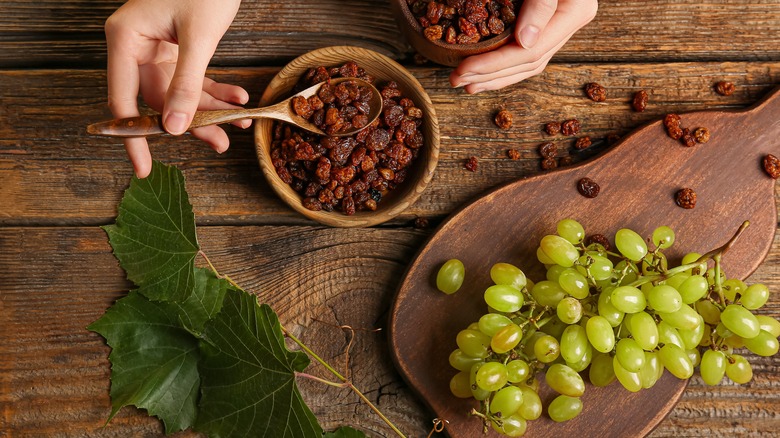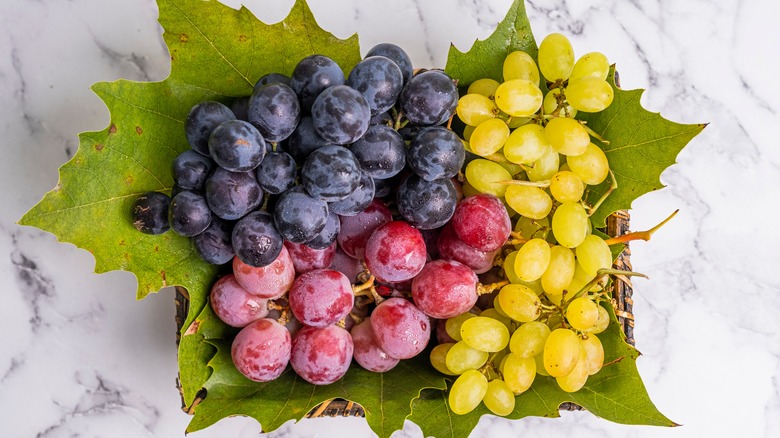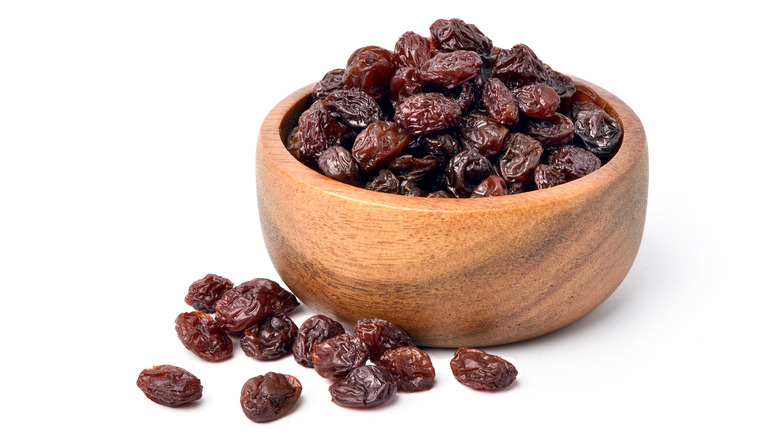Grapes Vs. Raisins: What's The Nutritional Difference?
Grapes and raisins are popular healthy snacks, whether eaten on their own or mixed into a fresh fruit salad or trail mix. According to Forbes, there are at least 10,000 types of grapes in the world, and not all grapes are made into wine like you would expect. Similarly, not all grapes are made into raisins. Although they are technically the same fruit, grapes and raisins do have some nutritional differences.
According to Healthline, one cup of either red or green grapes has 104 calories, 27 grams of carbohydrates, 1 gram of protein, 1.4 grams of fiber, 0.2 grams of fat, and 23 grams of sugar. In contrast, a quarter cup of raisins has 108 calories, 29 grams of carbohydrates, 1 gram of fiber, and 21 grams of sugar, per WebMD.
Using these amounts, one cup of raisins would have around 432 calories — more than four times the calories as one cup of grapes. Let's see what other nutritional differences grapes and raisins have.
Grapes are high in antioxidants and B vitamins and low in calories
Grapes contain copper, potassium, thiamine, and riboflavin. Copper helps the body create enough energy, and potassium helps open veins and arteries to improve blood flow, reduce high blood pressure, and eliminate excess sodium from the blood. Too much potassium may lead to adverse effects, so it's recommended to not consume more than 4.7 grams of potassium daily. Thiamine and riboflavin are B vitamins that help the body develop and grow properly (via Healthline).
Grapes are also packed with vitamins K, B6, C, and E. Vitamin C helps support the immune system, and vitamin K ensures healthy, strong bones. Vitamin E helps maintain healthy skin and hair, and vitamin B6 helps the body metabolize proteins.
Grapes also contain various antioxidants such as resveratrol and quercetin, which may help with high cholesterol and blood sugar and reduce risks of heart disease and certain cancers. The skin of grapes contains melatonin, which helps with sleep.
Grapes have anti-inflammatory properties and may support eye health and enhance memory and mood. While grapes do have 23 grams of sugar, their glycemic index (GI) falls between 49 and 59, making them a low to medium GI food.
Interestingly, eating too much of any food with a low GI could mimic the effect of eating foods with a high GI, raising blood sugar levels. Therefore, anyone with high blood sugar should eat grapes in moderation. Here's how to keep your grapes fresh.
Raisins are high in calories but may support heart health when eaten in moderation
Similar to grapes, raisins contain iron, copper, potassium, manganese, and vitamin B6 (per WebMD). Raisins also have boron, which helps support healthy bones and joints, may help heal wounds, and may enhance brain function.
The biggest benefit of raisins is that they may help minimize the risk of heart disease and help sustain healthy blood sugar and blood pressure levels. Raisins are also low in sodium and have anti-inflammatory properties.
Because of the drying process raisins go through, they have even higher antioxidant levels than fresh grapes. Antioxidants in raisins help minimize signs of aging, help repair damage in cells, and lower the risk of certain cancers, diabetes, and osteoporosis. Raisins also have antibacterial aspects that may aid in oral health, and the fiber content of raisins helps with digestion.
Similar to grapes, raisins have a low to medium GI, so they won't terribly alter blood sugar levels if eaten in moderation; however, raisins aren't as filling as grapes since they are dried, which makes it easy to eat too much and consume too many calories. Because of this, raisins may not be the best snack for anyone watching their calories. Furthermore, eating too many raisins can result in excess fiber consumption, which may lead to cramps, gas, and bloating.


